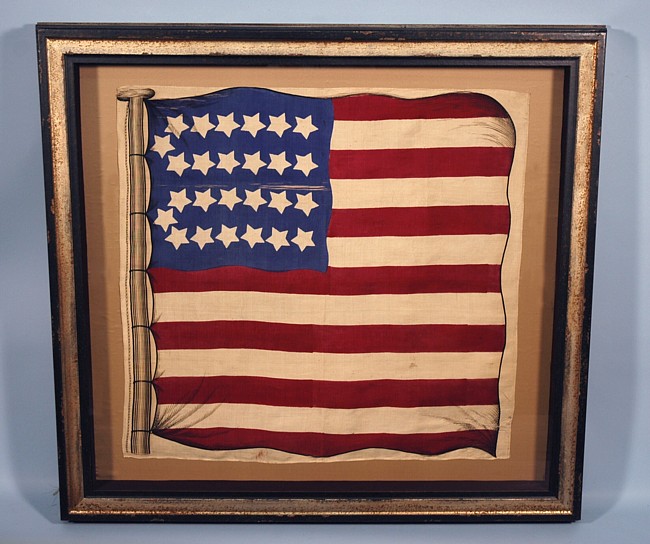
| |
26 STARS, the EARLIEST KNOWN STAR COUNT for PRINTED FLAGS, 1837-1846, MICHIGAN |
|
| Available: |
Sold |
| Frame Size (H x L): |
41.75" x 45" |
| Flag Size (H x L): |
32" x 33.5" |
|
| Description....: |
|
| 26 STARS, the EARLIEST KNOWN STAR COUNT
for PRINTED FLAGS, 1837-1846, MICHIGAN STATEHOOD:
26 star flag American parade flag, printed on silk, with 4 rows of 6 stars and 2 stars staggered before them on the hoist end. These roughly form two exaggerated "C's", a variation that is seldom seen in any star count. One edge of the silk has selvedge (beyond the fly end), and the other three sides are bound with hand-stitching.
The 26 star flag became official on July 4th, 1837, after the addition of Michigan. It remained so until the addition of the 27th state in 1845. The earliest known parade flags have either 26 or 13 stars (made during this 8-year period with patriotic respect for our colonial past).
There are but a handful of 26 star parade flags known, maybe fewer than 20 at present. The remainder from this era have 13 stars (with one exception), and these are equally few in number. Many of the examples are almost square in shape. This could reflect the square shape of infantry flags and regimental banner, or may simply be an unexplainable design choice of the flag-makers. Some parade flags of this era are more rectangular, and at least one company made nearly identical flags in both square and rectangular forms.
Three flags are known from this particular company, the name of which is unknown. All three flags have squarish proportions, are nearly identical in size, made of silk, and bear the same "Double-C" star configurations. The other two are not in waving form like this one, with printed shadowing and a printed staff. They are, instead, flat like the majority of parade flags. This particular flag is the only one known to exist in this waving style, which has very interesting folk appeal. Note the mushroom-cap finial at the top of the staff and the interesting coloration of the canton and stripes.
The fact that the canton rests on a red stripe is a very rare trait. Some flag historians refer to this as the "blood stripe" or the "war stripe", suggesting the flag was sometimes constructed in this manner when the nation was at war. There is also evidence that the Navy used this design feature on at least some of its flags made during the mid-19th century. And sometimes the placement was undoubtedly by accident. In any event, the war stripe is a highly desired feature in early American flags, and it is particularly rare in printed examples.
Mounting: The flag has been hand-stitched to 100% silk organza for support, then to a silk taffeta background, laid over a supportive archival backing, with cotton batting in-between. The flag was then pressure-mounted against u.v. protective plexiglas for additional support of weak areas. The black-painted, hand-gilded and distressed Italian molding is contemporary.
Condition: There are several lateral splits in the silk fabric. Blue cotton fabric was stitched in place behind the canton to mask the damage in that area. One of these splits, at the bottom corner of the fly end, was whip-stitched at some point in its history to minimize further separation. The colors are very strong. The condition is remarkable considering the fragility of the textile, its age and rarity. This is pre-weighted silk, which helps to explain its state of preservation. After around 1850, silk began to be sold by weight as opposed to length. As a result, merchants added mineral salts to their silk to increase its weight and price. Mineral salts were caustic to the fabric, often causing extensive breakdown in post-1850 examples. |
|
|
|
| Collector Level: |
|
|
| Flag Type: |
Parade flag |
|
| Star Count: |
26 |
|
| Earliest Date of Origin: |
1837 |
|
| Latest Date of Origin: |
1845 |
|
| State/Affiliation: |
Michigan |
|
| War Association: |
1777-1860 Pre-Civil War |
|
| Price: |
No |
|
| |
Views: 2807 |
|
|
|

